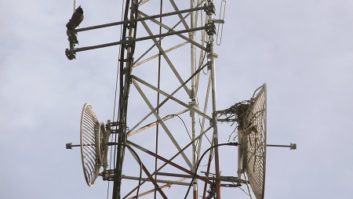
This FCC map shows potential availability for new LPFM stations based on rules adopted in November. This does not assume protection of other second-adjacent FM stations.
(Click to Enlarge)
A newly formed citizens’ group, Let The Cities In, has filed a Petition for Reconsideration of the FCC’s final rule on low-power FM implementation. The petition asks the commission to allow LPFM stations below 50 watts in the most urban 1 percent of America’s land area.
The sources cited [see sidebar] will confirm that only LPFM stations below 50 watts are small enough to “fit” into the spectrum in certain metropolitan areas. However, written statements made by commissioners on Nov. 30, when the final LPFM rule was adopted, indicate they may not have not been informed of this fact.
For example, at the meeting, Chairman Julius Genachowski stated: “These stations are doing fantastic things, but now only a handful of low-power FM stations operate in large markets. With today’s vote, we are fully realizing the vision of creating an opportunity to bring the diverse voices of community radio to Americans across the country, including those in large urban areas.”
These do not sound like the words of a man who knows he has just voted to ban all LPFM stations in New York City and Detroit. That is: By voting to allow only LP100 stations (50 to 100 watts) in all locations, he has left these cities with no LPFM stations at all, we believe.
Commissioner Mignon Clyburn addressed Pennsylvania Democrat Rep. Michael Doyle and Nebraska Republican Rep. Lee Terry, the two leading LPFM advocates in the House who were present. She stated:
“Special thanks are due to you, for none of this would be possible without your tireless efforts. Now, more constituents in Pittsburgh and Omaha may have their voices heard, and their interests expressed.”
Unfortunately, Commissioner Clyburn — a sincere and fervent friend of LPFM — was only halfway correct. According to REC’s “My LPFM Channel Search Tool,” Omaha will have 13 frequencies for LPFM stations. However, Pittsburgh will have only one.
Perhaps the commissioners overestimated the positive impact of allowing second-adjacent channel spacing waivers. In some cases, the waivers are decisive. They are the only reason for LPFM frequencies in Seattle (nine), Philadelphia (three), Los Angeles (two), Chicago (two), San Francisco (two), Washington (two), Boston (one) and Pittsburgh (one).Also, waivers increased frequencies from three to 11 in Phoenix, three to 13 in Omaha and two to 13 in Houston. Still, the impact of waivers is uneven, and some cities lack any LPFM at all. Even with waivers, America’s three largest cities have four frequencies between them, while the country as a whole has thousands.
Someone at the FCC apparently did not apprise the commissioners that they were approving a seriously truncated version of urban LPFM.
The reconsideration petition
The remedy for flawed commission consideration is a Petition for Reconsideration. I filed such a petition in December, asking for stations below 50 watts in “urban core” portions of the Top 100 Arbitron Radio Markets. I added that the LPFM filing window should be suspended only in these highly urban areas.
I acted as attorney for the newly formed citizens’ group behind the petition called “Let The Cities In.”
Spectrum Scarcity
Docket 99-25 is the LPFM rulemaking file in the public comments portion of www.fcc.gov. There, posted on Dec. 11, find the text of the final rule and statements by individual commissioners as well as reply comments by The Amherst Alliance of Connecticut and separate reply comments by myself as an individual. Both documents contain, in the appendices, an LPFM frequency analysis titled “Dealing With Spectrum Scarcity in LPFM Licensing.”
Also see the website for REC Networks of Maryland, led by Michelle Eyre, at www.recnet.com/lpfm. In her “My LPFM Channel Search Tool,” check out what Eyre believes to be the availability of frequencies for new LPFM stations nationwide. Readers can select specific locations to determine how many frequencies may really be available under the FCC’s new rule.
— Don Schellhardt
Our group asserted that the commissioners evidently were under-informed when they voted. However, our most important argument is constitutional. As the FCC was already apprised in earlier written comments, the “LP100s only” policy, when applied to highly urban areas, violates the constitution’s “Equal Protection of the Laws” clause. The policy disproportionately disempowers our cities, which means — in practice — that it disproportionately disempowers racial and ethnic minorities. Case law establishes that government policies with a racially discriminatory effect, even if there was no racially discriminatory intent, are unconstitutional unless a “compelling state interest” can be shown. There is no “compelling” reason to ban urban LPFM stations below 50 watts.
Don Schellhardt, a former Washington attorney, is a grassroots activist for media reform. He co-founded the advocacy group The Amherst Alliance and represents other “under-represented” causes including reform of homeowners’ associations and equipment shielding against an electromagnetic pulse. Contact him at: [email protected]









